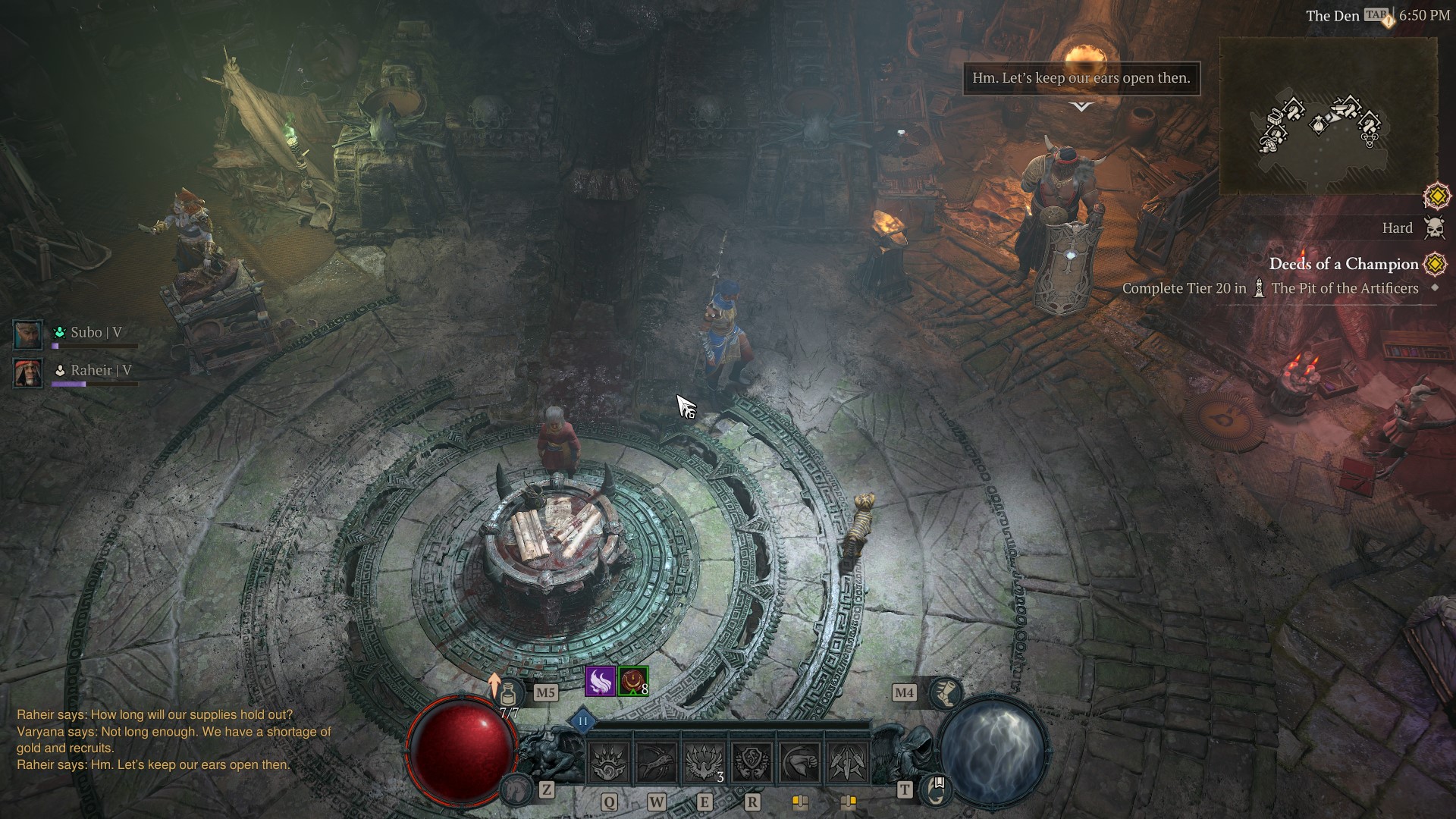
What is it? A massive update and expansion to the dark fantasy action RPG.
Release date October 7, 2024
Expect to pay $40/£40
Developer Blizzard
Publisher Blizzard
Reviewed on RTX 4090, Intel Core i9 12900K, 16GB RAM
Multiplayer Yes
Steam Deck Verified
Link Battle.net/Steam
In a little over a year since its original release, Diablo 4 transformed from a decent action RPG into one of the best, a post-launch metamorphosis that few games have pulled off so thoroughly and so swiftly. Blizzard took every single thing players didn’t like about it and made them better. Every dungeon and every piece of loot was remade to better fit how people actually want to play a game about clicking demons until they pop. And now Diablo 4 is easily one of the best action RPGs of the last decade.
Its first expansion, Vessel of Hatred, marks the end of its post-launch renovations and the start of its vision for the future. That vision includes a brighter, more expressive Diablo 4 than before, one where its story isn’t so bleak that it borders on parody (an overcorrection after complaints that Diablo 3 was too cartoonish), and one where everyone gets an inventory’s worth of toys to play with as they ascend to demon-slaying godhood. Diablo 4 is no longer afraid to let me find my own way through its dark fantasy world. It finally understands that Sanctuary, no matter how disastrous its history has been, has always been shaped by its players and what they decide to do in it.
Vessel of Hatred’s campaign cements this shift in philosophy for the game. It follows in the footsteps of Neyrelle, the young woman from the first game who is carrying one of the series’ major villains, Mephisto, demon lord of hatred, in her pocket. She’s on her way to Nahantu, the jungle region on the southern tip of the game’s map and your character, the Wanderer, chases after her to help. Your character has much more to say in Vessel of Hatred than they did in the original campaign, and I’m surprised at how pleased I was to see the hero of the story do more than nod and fight monsters. Vessel of Hatred’s campaign is shorter than the original one—clocking in at around 12 hours—but it’s dense with scenes where characters reflect, mourn, argue, and even tell jokes.
Having more human characters by your side doesn’t rob Diablo of its darkness, it enhances it, lending relief and contrast to its most horrific moments. Nothing feels out of place when my character cares for her friends in cutscenes and spends the rest of her time slaying as many demons as possible. It’s just enough motivation to make me believe it without breaking what Diablo is ultimately about. I never would’ve thought I’d play a Diablo game where my character earnestly tells their friend that they don’t have to do this alone, and that the monsters that torment the world prey on the insecurities that fester when no one is there to tell you it’s okay. Vessel of Hatred introduces compassion to the world of Diablo when it needed it most.
The original campaign was a grimdark fantasy determined to find the villain in everyone. Vessel of Hatred imagines a much kinder world. Its characters know that it’s ultimately doomed to endure an eternal war between heaven and hell, but they still care for each other anyway. For a game where you battle thousands of demons for sport, I think that’s as hopeful as you can get.
Better together

Companionship isn’t just a theme in Vessel of Hatred’s story, it’s also core to a lot of what the expansion brings to the game. Mercenaries are back from Diablo 2 and 3, and this time they’re a group of exiled misfits who can aid you in combat. I brought the bloodthirsty Varyana along with me for her stacking movement speed increase from killing several enemies in a row, and assigned my main attack to call in Raheir to periodically bolster me with passive damage reduction. Vessel of Hatred’s mercenaries can fill the gap in your character’s build by either permanently following you as a companion or lending you a hand when you activate a chosen skill. And after spending over 40 hours blasting through dungeons with their help, I don’t think I could live without them.
I frequently stopped to listen to my mercenaries’ banter whenever I teleported back to The Den, their underground base in Nahantu. I heard Raheir, an old-warrior-turned-father, telling the others about his daughter, and the rest of the crew taking turns asking Varyana to cook her rancid meals somewhere else. The mercenaries aren’t just a set of skills to make your damage go up, they’re just interesting people who are fun to be around.
These little sparks of humor and warmth balanced out the amplified horrors of Vessel of Hatred’s corrupted jungle and new dungeons. Sections of Nahantu are drenched in tar and filled with undulating, tentacled abominations. It’s disgusting and over-the-top in exactly the way a Diablo game should be. One of the bosses I fought looks like a goopy octopus that crawls along the floor and enrages halfway through the fight. The camera pulled out like it was an Elden Ring boss entering its second phase and all I could do was dodge roll out of the way as it slammed its tentacles into the ground. And underneath the temple city of Kurast, I encountered a snake boss surrounded by statues that forced me to hide as it filled the room with heaps of gold. The monsters of Vessel of Hatred are significantly more creative and more tactically demanding than the ones in the original game.
I had no problem tearing them apart with my spiritborn, Vessel of Hatred’s ridiculously flexible new class. Warriors of Diablo 4’s spirit realm, spiritborn fight with martial arts infused with the supernatural powers of their animal gods. Each one serves a similar role as the different elements sorcerers can use but the spiritborn skill tree and items encourage you to use a mix of two or more. I settled into a build that let me fling out electric eagle feathers and pounce on enemies with a fiery jaguar ultimate that reset on kills. I was tearing through dungeons so fast that I almost felt bad for the demons.
Diablo 4 already had unparalleled combat where you can feel every hit land and see every spell light up the room, but the speed and spectacle of the spiritborn demonstrate how far you can push it without losing the friction that so many other action RPGs seem to neglect. I dabbled in Last Epoch and Path of Exile this year and my characters felt like a wet sponge sliding along a countertop; Diablo has spoiled me with its tactile action and Vessel of Hatred only makes it even more satisfying.
Build-brained
That’s great news for a game that isn’t going to end anytime soon, and bad news for the games that I’m going to neglect as every new season in Vessel of Hatred debuts. No other live service game I’ve played is as generous as Diablo 4’s seasons and I expect that to carry forward into the expansion. While the early access build I played for review had the newest season available in it, bugged loot rewards (that will be fixed when it launches) made it impossible to get a good idea of how it’ll work when it goes live at the same time as the expansion drops.
What I can tell you is that Vessel of Hatred’s soft reset of Diablo 4’s progression systems, specifically how you level your character up and climb through its increasingly tougher and lucrative difficulty tiers, is the bow that neatly ties together the last several months of iteration that it’s gone through. Taking a character from level 1 to 60 is a much shorter journey than before, but it’s filled with exciting loot drops and challenges that ease you into shaping your character’s build.

The more time I put into it, the more the patterns in its design reveal themselves.
As you gather up powerful legendary items that augment your skills, like one that makes your spiritborn’s eagle feathers ricochet off walls, you’ll reach a point where you have to consider survivability. This is where Diablo 4’s loot and malleable skill tree shine. After its major loot rework earlier this year, each piece of equipment meaningfully impacts how you play your character and asks you to make careful decisions about how you build them.
I was lucky and found a unique helmet that let me spam my most powerful attacks much faster than before, but I had to give up a legendary power that gave me extra armor. I took the risk and found a few points in my skill tree I could move around to gain a bit of extra health. My spiritborn was suddenly made out of paper and the only way to survive was to swap one of my offensive skills out for a defensive one. I continued tinkering with my items, sometimes replacing them or using Diablo’s tempering system to apply defensive stats onto them. After a few hours I had massaged my build into one that had a good balance of damage output and survivability, and then a mythic ring—the rarest and most powerful items in the game—dropped off a boss and I suddenly had a whole new puzzle to solve.
That’s why I keep playing Diablo 4 and have no plans to stop with Vessel of Hatred. The more time I put into it, the more the patterns in its design reveal themselves, like how leggings tend to be a perfect spot to stack all your extra health and armor. And how the designers break those patterns in clever ways: The unique Tibault’s Will pants skyrocket your damage but omit most of the stats leggings usually have on them. Vessel of Hatred sprinkles even more smartly designed loot into the mix, including a spiritborn chestpiece that drains your health to make your cooldowns shorter. I’m now determined to figure out how to make a low-life build with it as soon as I find one. And the best part is that no season will be the same as Blizzard continues to add new loot to chase.
Diablo 4 spent the last year reconfiguring itself into a phenomenal action RPG and Vessel of Hatred demonstrates that Blizzard isn’t out of ideas on how to improve it further—even on the narrative side of things. Its willingness to stretch what Diablo could be is what impresses me most and the trust it’s earned along the way makes me confident about its future and thrilled to be along for the ride.






